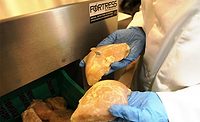Automation
ERP software helps keep bad product from consumers
Today’s cloud-based ERP software can track products in near real time

The U.S. meal kit market is expected to hit $5.50 billion by 2023, which should come as no surprise as more people start to favor the convenience of online grocery. However, as this space continues to grow, it also poses huge risks.
For example, in January 2019, both Hello Fresh and Chefs Plate had meal kits recalled for Salmonella risks. And as the chain of ingredient suppliers continues to expand globally, food recalls show no signs of slowing—having doubled over the past 3 years.
To combat this issue, food suppliers must have complete visibility into the supply chain to determine the state of each product used in subscription meal kits.
Various software applications, such as ERP, can track products through the supply chain, providing immediate visibility to where those products are, and if a food safety problem is discovered along the way, these software tools have the potential to stop a shipment of bad product in its tracks. In addition, ERP software can provide data showing who has the product and what its status is in the supply chain.
I asked Kevin Beasley, CIO of Vormittag Associates, Inc. (VAI) what role ERP software can play in tracking food throughout the supply chain. Beasley oversees both the VAI’s technology strategy in conjunction with product development and the internal information technology initiatives that support the goals of the company. He has over 20 years ERP, SCM, and WMS consulting experience and over 30 years IT experience.
VAI’s ERP is available in both cloud and site versions and can provide lot and date tracking, broken-case unit conversions, catch weight pricing, truck routing, flexible contract pricing and manage rebates, promotions, and bill-backs.
FE: Food processors who are creating ready-to-eat (RTE) sandwiches or the like or are preparing ready-to-go meal kits are at the mercy of their suppliers. This doesn’t sound so much like a problem that software can fix, rather it is incumbent on the processor to be sure that the ingredients coming from suppliers are safe. So, what role can software play in this instance?
Kevin Beasley: Meal kit providers, like all distributors, processors and retailers, need to ensure they have the right processes in place to comply with food safety regulations, such as tracking refrigeration temperatures, lot and date labeling, inventory management, and truck routing, to name a few. For many of these companies, technology solutions are the best way to ensure accurate tracking and management of ingredients, as well as the only sure way to follow regulations and streamline efficiency in today’s complex environment. With solutions like real-time data visibility, suggested purchasing applications and mobile tracking capabilities, many companies are using these technologies to reduce the risk of foodborne illnesses and contamination issues by tightly managing their inventory and automating business processes.
FE: Can software verify that suppliers have met a processor’s requirements and tested all materials leaving their premises?
Beasley: Yes, software can absolutely verify that suppliers have met a processor’s requirements and tested all materials leaving their premises. Many ERP solutions leverage integrated document management systems to help ensure that suppliers have provided all the documentation required to meet FDA regulations.
When on-boarding a new supplier, document management systems can track whether the vendor has provided documents such as Proof of insurance, USDA Grant of Inspection, HACCP/HARPC plan, and more. Additionally, these tools help ensure that all the necessary documents have been provided for individual items and for each shipment.
Once received, processors can also track that food was delivered at the correct temperature and that lot, production date, and country of origin information have been provided. In delivery, transport is a critical phase that can lead to contamination and recalls, so it’s important distributors have transparency and control over which trucks product is being carried in, so they can determine temperature, journey length, and other critical factors.
FE: Can software help verify a supplier is meeting FSMA and cGMP requirements?
Beasley: Software solutions should always have built in processes that ensure compliance to FSMA and cGMP regulations when dealing with the food supply chain. Since FSMA went into effect in 2011, the goal is to better regulate the way foods are grown, harvested and processed, with an emphasis on safety. Food suppliers and retailers adopt software that can automatically track and follow the requirements of FSMA such as temperature, processing time, labeling, and more. Similarly, cGMP requires quality manufacturing processes, and software systems are also able to help manufacturers follow these practices and guidelines with real-time analytics and suggested purchasing applications. Overall, technology has been a huge enabler of ensuring compliance in the supply chain.
FE: Can ERP show what suppliers have had a record of shipping bad ingredients?
Beasley: As the food supply chain looks for new ways to improve food safety with the addition of meal kits, companies in the distribution supply chain can utilize ERP technology to gain the visibility and tracking tools needed to follow food safety regulations and improve efficiency. Through the use of a Quality Control system, processors can track each ingredient used in food kits by lot number, and should there be a recall for a bad ingredient, they can trace the ingredient to the supplier. Keeping these records helps a processor facilitate a recall if required and track which suppliers have a history of safety issues.
FE: Incidents with bad ingredients point up the need for mock recalls—to be sure bad product doesn’t get out the door. After all, if it hasn’t gone out the door, nobody has to know (media, purchasers, etc.) so a food company has been spared the anguish of a real recall—where people may have been sickened or died. What is the role of ERP in this situation?
Beasley: ERP solutions enable real-time tracking and visibility into inventory management. You know exactly how long a product has been on the shelf, and in cases where a food producer alerts you of contamination down the line, distributors know exactly where the batch is in transit so they can get the situation under control in a matter of hours, and ensure the food isn’t distributed further. Companies who do not have that type of visibility are getting a hold of tracking too late, so it might already be on the shelves. Like a mock recall, ERP software tracking can be a way to better prevent unsafe food from reaching the shelves. At the same time, having the best tracking applications in place is an efficient way to reduce recalls and prevent the need for facilitating a mock recall as well.
FE: What other technologies do you see on the horizon that can help?
Beasley: Technology has the power to ensure compliance and improve food safety measures throughout the supply chain. With the availability of 5G in the next several years, food traceability will become more modernized and cost-efficient. 5G networks can connect low-power devices and IoT sensors to automate tracking applications and data collection. This will only optimize food processing to ensure safe products make it to the shelves. With 5G, food supply chains will not only become safer and more cost-efficient for processors and retailers, but more transparent for consumers as well.
Looking for a reprint of this article?
From high-res PDFs to custom plaques, order your copy today!






